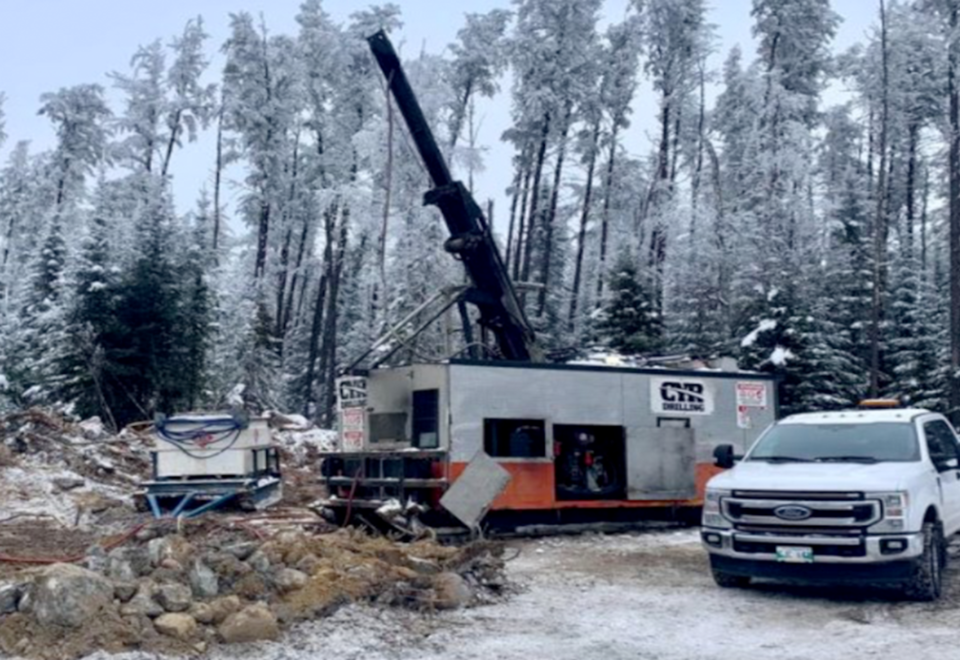Eleven months after acquiring the Mavis Lake lithium project, Critical Resources Ltd. has put out a resource calculation.
The Australian junior miner posted a maiden resource showing 8.0 million tonnes at 1.07 per cent lithium oxide on its property, northeast of Dryden, based on 11 months of continuous drilling.
“It’s a line in the sand,” said Alex Cheeseman, managing director in a May 5 investor webcast. “It’s a maiden resource and we’ll grow from here.”
Cheeseman let it be known last week they have no intention of letting their foot off the gas. There will be more results to come as they’ve drilled off only two per cent of the 22,984-hectare property. Drilling continues at a main zone at Mavis Lake and some outcropping occurrences on the property.
Lithium is considered the ‘battery metal,’ given its wide ranging use in electric vehicle batteries and many other digital devices and applications.
The resource estimate is inferred which means the geological information is limited. More closely spaced drilling will upgrade the resource to indicated, considered a higher category of confidence.
The company expects to deliver an updated estimate in the first half of 2024, which will show the indicated resource in the spodumene-bearing pegmatite host rock. Spodumene is considered the most important lithium ore mineral because of its high lithium content.
Cheeseman said their goal is to grow the resource as large as possible and he expects Mavis Lake will likely surpass the 10 to 12-million tonne mark.
The company said it’s gradually making the transition from an exploration outfit to lithium mine developer. They have already started environmental and technical studies to that end.
While not comparable to the large bulk mining operations of Western Australia, Cheeseman said there’s enough lithium at Mavis Lake to trigger a “small, high-margin business” that can supply the North American market.
“I would put Canada and Western Australia as your two premium hard-rock lithium districts, globally,” he said.
As the technical studies continue, the field plan for this spring and summer is to do bedrock sampling and geological mapping of two nearby lithium prospects in the pipeline, Gullwing and Tot Lakes, immediately north of the Mavis Lake Main Zone. The company is confident of making more discoveries there.
Critical Minerals is one of a handful of leading lithium players in northwestern Ontario with a defined resource. They join fellow Australian explorer Green Technology Metals along with Frontier Lithium, Avalon Advanced Materials and Rock Tech with plans to establish both mines and processing facilities either in Ontario or overseas.
Sign up for the Sudbury Mining Solutions weekly newsletter here.
Cheeseman said the location of Mavis Lake certainly has its advantages.
It’s relatively close enough to supply the North American electric vehicle car and battery manufacturers with product.
The project is one kilometre off the Trans-Canada Highway that runs east to the Port of Thunder Bay where Cheeseman suggests a lithium product could be exported to manufacturers like Tesla, where it is building a lithium refinery in Corpus Christi, TX, or overseas to supply the European market.
But from an exploration and development standpoint, Mavis Lake is 19 kilometres from Dryden, a community with all the amenities needed to support a mine.
“We draw on Dryden right now for this phase of the company’s life,” said Cheeseman, mentioning all the industrial, maintenance and logistical support available there.
The company’s geologists are in long-term accommodations in town and are spending money in the community. That augers well in any future financial modelling for an operation.
Cheeseman said it allows them to put most of their project dollars straight into the drill bit and the technical management of the program.
The benefit of having Dryden nearby should keep costs low in carrying them straight into mine construction and operations, he added.
There’s no need to build a work camp, any access roads, or a communications network. Hydro transmission lines surround the property, Cheeseman said.
“We don’t have a remote camp that we’re sending diesel to every month. We don’t have to helicopter in drill rigs.”
The people of northwestern Ontario, Cheeseman said, are “very supportive” of the industry. Canada is a “very well-regulated” mining jurisdiction and the Canadian government is getting behind the push to find more critical minerals.
But he said they must balance their heady aspirations by engaging with area communities and First Nations to diligently move the project forward in a responsible way.
Critical Resources and Cheeseman haven’t announced any offtake agreements with strategic partners to help finance a mine, but that doesn’t mean they haven’t been approached. He said there have been in discussions with plenty of interested parties significant project funding offers, but have seen nothing attractive yet that will result in a deal.




